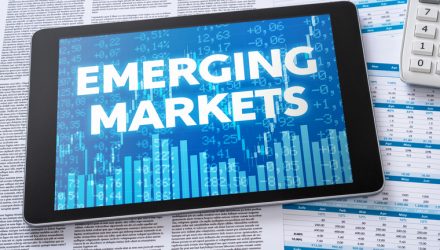Domestic aggregate bond strategies are on pace for decent showings this year. And there is mounting speculation that the Federal Reserve will lower interest rates next year, perhaps multiple times. So enthusiasm for bonds and related exchange traded funds is perking up. That doesn’t mean investors should limit 2024 fixed income ETF considerations to U.S. fare. The dollar is already retreating, implying market participants are comfortable with the idea of Fed rate cuts. So emerging market bonds could be worth considering in 2024.
Enter the VanEck J.P. Morgan EM Local Currency Bond ETF (EMLC) and the VanEck Emerging Markets High Yield Bond ETF (HYEM).
Emerging market equities are again disappointing investors this year. But the tale of the tape for bonds is markedly different. EMLC and HYEM are sharply outpacing the MSCI Emerging Markets Index. Yet the VanEck ETFs are doing so with significantly higher yields and noticeably less annualized volatility.
Emerging Market Bonds Worth a Look
As its name indicates, EMLC holds bonds that are denominated in local currencies. Understandably, many investors think that a weaker dollar, which means strong currencies elsewhere in the world, is punitive for the issues held by EMLC. However, recent price action suggests otherwise.
“For instance, EMFX has rallied over the past two months as U.S. bond yields have declined, but has contributed only approximately +1.3% to a total return of approximately +8.4% this year. We believe a similar dynamic could play out next year, with EMFX supported but carry being the primary driver of total return,” according to VanEck research.
The $3 billion EMLC offers some buffer against downside with a 30-day SEC yield of 6.56%. Additionally, more than 70% of the fund’s holdings carry investment-grade ratings. And the bulk of its largest country exposures are unlikely to raise interest rates next year.
As for HYEM, there’s a case for emerging markets junk debt, too. While many novice bond investors ignore this asset class due to perceived risk, HYEM cushions some of the associated volatility with a 30-day SEC yield of 8.43% and a relatively low duration of 3.33 years. Plus, less than 7% of the ETF’s holdings carry the most speculative junk ratings.
“With resilient fundamentals and net issuance that is expected to remain muted next year, we see continued support for spreads which may help balance against macro uncertainty,” added VanEck. “Notably, although most U.S. investment grade bond indexes include emerging markets borrowers, U.S. high yield bond indexes and associated products do not, and so EM high yield bond allocations can add significant diversifications at the borrower level.”
For more news, information, and analysis, visit the Beyond Basic Beta Channel.







